Recent Articles
Popular Makes
Body Types
2022 Hyundai Tucson vs. 2021 Toyota RAV4
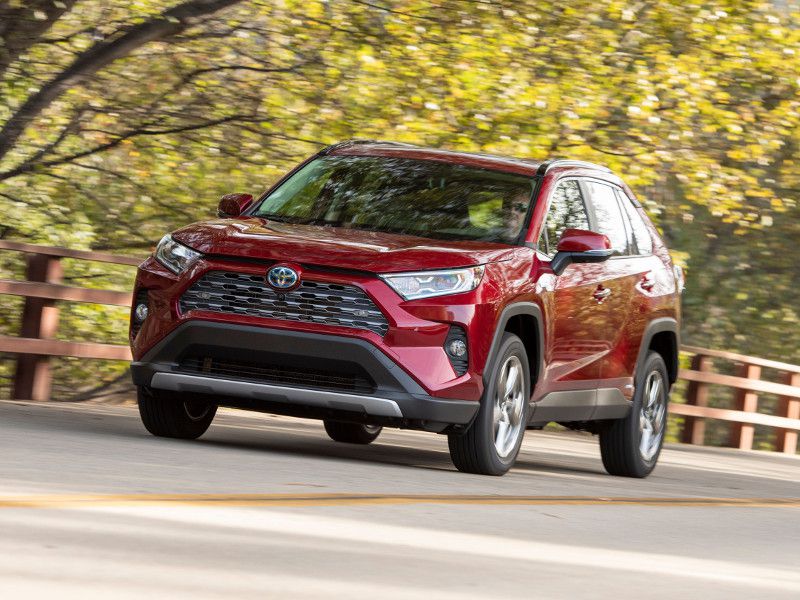
2019 Toyota RAV4 ・ Photo by Toyota
The Toyota RAV4 has ruled the roost in the compact crossover segment for several years now, but a new challenger has come on the scene that is poised to steal at least some of the RAV4’s thunder. The 2022 Hyundai Tucson is an all-new version of what has become Hyundai’s best-selling vehicle in the United States. Six inches longer than the previous version, the 2022 Tucson is a little larger than the RAV4 and has more interior space, so it delivers on what consumers in the SUV space have been asking for. Like the RAV4, the Tucson offers both hybrid and plug-in hybrid variants in addition to a conventionally powered model. After driving both the RAV4 and the Tucson extensively, it's obvious there is plenty to like about both. They both offer a great deal of comfort and convenience in normal on-road driving, and they have the ability to negotiate moderately difficult off-road situations.
Exterior
The all-new 2022 Hyundai Tucson has a very expressive look. Hyundai executives say the Tucson's styling is an evolution of the brand’s “Sensuous Sportiness” design ethos. This is epitomized by the heavily sculptured side panels with pronounced bulges over the wheels. The idea is to distinguish the Tucson in a very crowded market. Meanwhile, the Toyota RAV4, deep into its fifth generation, has already accomplished that, drawing inspiration from the Tacoma mid-size pickup truck and the 4Runner SUV. The RAV4’s most distinctive feature is its front end — a big, bold grille jutting in a long overhang past the front wheels. The Tucson’s nose is more subtle and incorporates hidden daytime running lights that appear only when illuminated, creating a special “light signature.” To our eyes, the RAV4 is more rugged-looking than the Tucson, while the Tucson is more sophisticated.
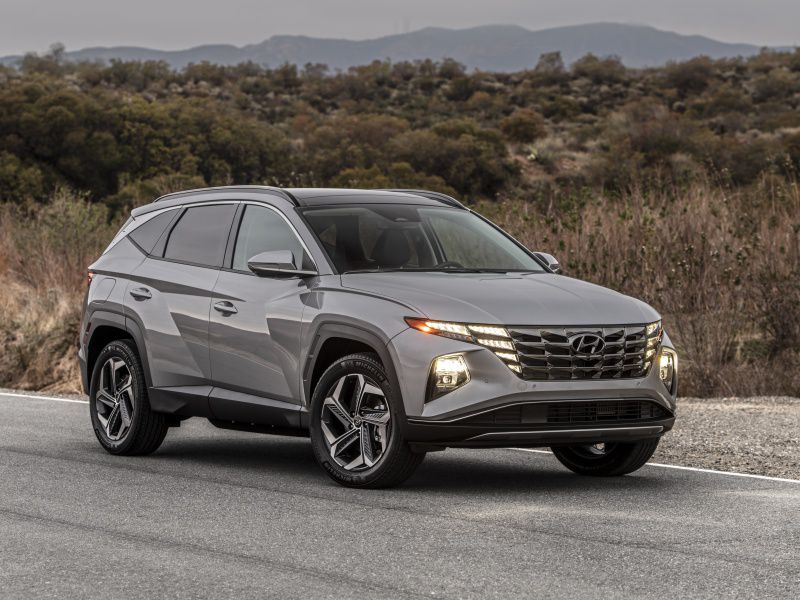
Photo by Hyundai
Interior
Both brands offer attractive and functional interiors that are designed to turn on the increasingly demanding compact SUV customer. The 2022 Hyundai Tucson has a horizontal theme in the front compartment. In most versions of the vehicle, the horizontal motif is enhanced by two 10.25-inch touchscreens; one is for the infotainment, and the second houses the instrumentation and driver information. Because of its brightness and resolution, the instrumentation display doesn’t require a hood to protect it from glare — a modern touch. The four-spoke wheel features a variety of controls, some of which are also offered in the center console. The Tucson’s second-row seats feature a fold-and-dive function, enabling quick configuration changes.
As the current generation of the RAV4 has matured, Toyota has made an extra effort to add luxury and style. Niceties like dual-zone climate control are standard in all but the basic LE model. The RAV4’s 60/40 split reclining rear seat with center armrest and cup holders folds flat for cargo loading. The Tucson also has a 60/40 split second-row seat, and it has a reclining seatback.
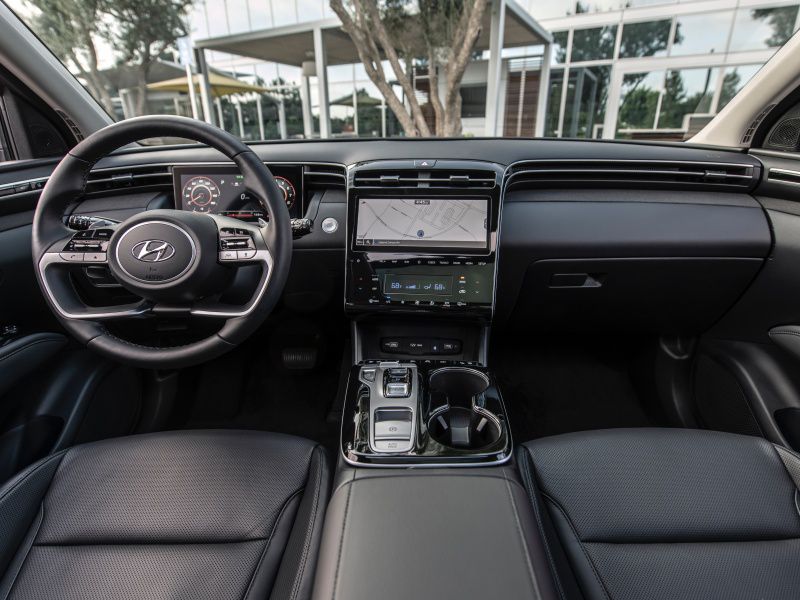
Photo by Hyundai
Infotainment
Depending on their trim levels, RAV4s offer 7- or 8-inch Toyota Entune infotainment systems. Android Auto, Apple CarPlay, and Amazon Alexa compatibility are widely available. The base-level infotainment system offers six speakers, a 7-inch touchscreen, AM/FM radio, Bluetooth, voice recognition, Siri Eyes Free, an auxiliary port, and a USB media port. As good as the RAV4 systems are, the Hyundai Tucson one-ups them with a standard 8-inch touchscreen and an available 10.25-inch touchscreen. Apple CarPlay and Android Auto are standard across the lineup, and wireless Apple CarPlay and Android Auto are offered (oddly enough) with the 8-inch touchscreen system. Qi wireless charging is available as well. The Tucson navigation system offers split-screen functionality, and an 8-speaker Bose audio system is available. The current RAV4’s infotainment offerings are significantly upgraded versus previous units, but we still favor the all-around functionality and ease-of-use of the Tucson’s system.
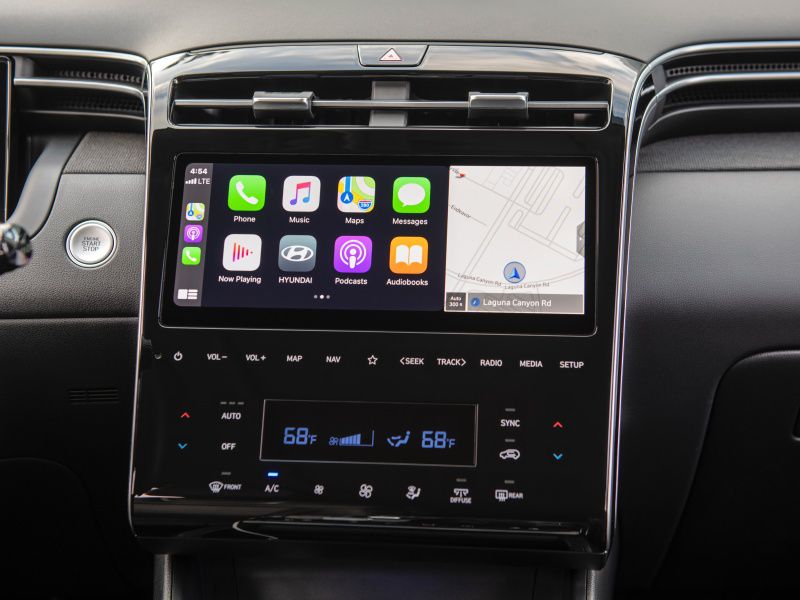
Photo by Hyundai
Powertrains
The 2021 Hyundai Tucson offers a variety of powertrain choices, including both hybrid and plug-in hybrid models. The base engine is a 2.5-liter four-cylinder that delivers 187 horsepower. It drives either the front wheels or all four wheels via an 8-speed automatic transmission. The Tucson’s hybrid powertrain uses a 1.6-liter turbocharged four-cylinder plus a 44.2 kW electric motor to produce an estimated 226 horsepower. The plug-in hybrid kicks that up to 261 horsepower.
The Toyota RAV4 has three powertrains — the conventional gasoline-powered version, a conventional hybrid, and the plug-in hybrid RAV4 Prime. The conventional RAV4 is powered by a 2.5-liter 203-horsepower naturally aspirated four-cylinder engine that offers a 184 lb-ft of peak torque. Both front-wheel drive and all-wheel-drive versions are offered. The hybrid powertrain uses a modified 2.5-liter four-cylinder engine in tandem with electric motors to drive both front and rear wheels. It delivers 219 horsepower. The RAV4 Prime uses the hybrid’s 2.5-liter four-cylinder Atkinson-cycle engine paired with the electric motors for a total system output of 302 horsepower.
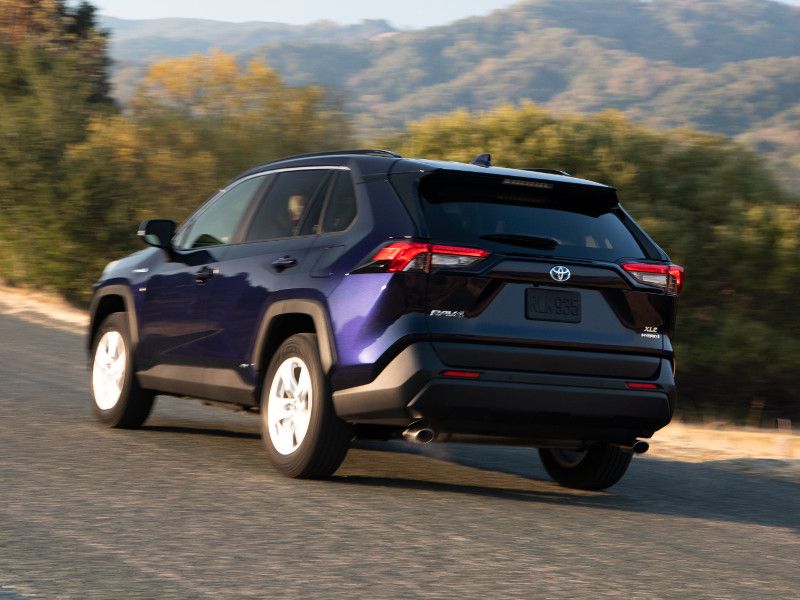
Photo by Toyota
Driving Impressions
The conventional Hyundai Tucson lacks the horsepower of the conventional Toyota RAV4, but in everyday driving, one doesn’t notice much difference between the two. Both are all-around competent in normal situations. The impressions change, however, when you consider the plug-in hybrids of each. The Toyota RAV4 Prime, with its 302 total horsepower, is a joy to drive because of its speed and near-instant torque. We have yet to drive the plug-in Tucson, but with 40 fewer horsepower, it won’t be nearly the hot rod the RAV4 Prime is. The two conventional hybrid-powered vehicles have similar power numbers and perform about the same. One advantage of the Tucson hybrids is the e-handling technology that routes torque and braking to aid cornering precision. The riding experience of both the RAV4 and the Tucson lean toward comfort. Both vehicles are cushy, quiet, and easy to maneuver. If you seek off-road prowess, the RAV4 trims like the Adventure and TRD Off-Road are the most competent.
: Toyota RAV4
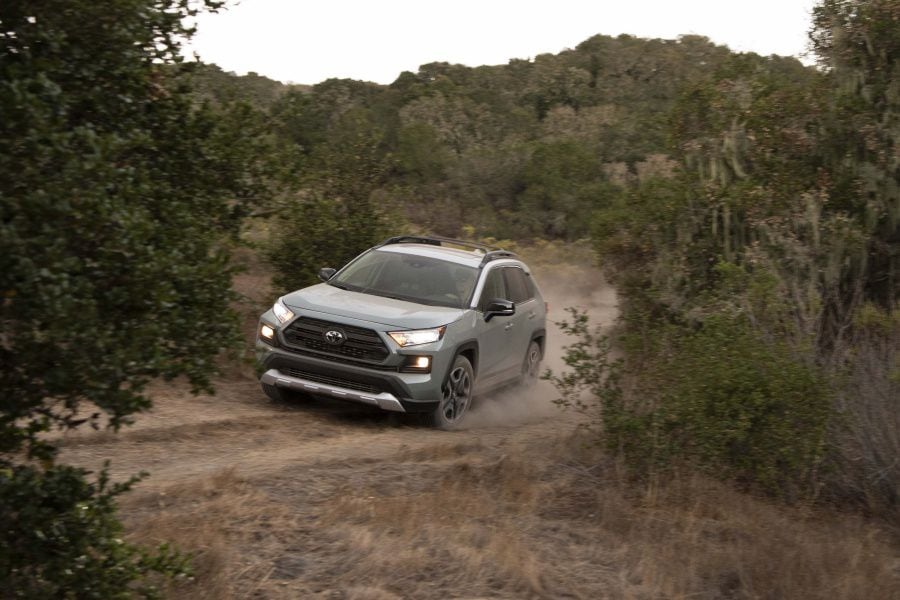
Photo by Toyota
Safety and Driver Aids
The 2022 Tucson has several standard safety features and even more optional ones. Forward collision avoidance with pedestrian and cyclist detection, lane-keeping assist, rear occupant alert, driver attention warning, and high-beam assist all come standard. On the options list are blind-spot collision avoidance assist, rear cross-traffic collision avoidance assist, safe exit warning, and adaptive cruise control with stop and go. Remote Smart Parking Assist allows a driver to park and retrieve his vehicle from a tight parking space while they are outside the vehicle. The Toyota RAV4 features a comprehensive standard safety package called Toyota Safety Sense 2.0. Among the included electronic driver and safety aids are a pre-collision system with pedestrian detection, lane departure alert with steering assist, and automatic high beam headlights. Lane tracing assist, road sign assist, and full-speed adaptive cruise control are also part of the suite of systems.
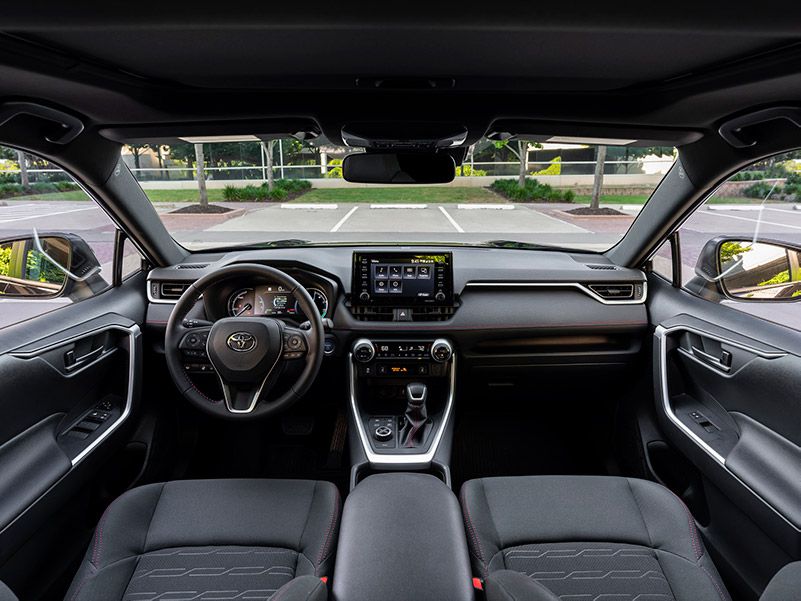
Photo by Toyota
Interior Space and Cargo
In the field of compact crossovers, both the 2022 Hyundai Tucson and the 2021 Toyota RAV4 are among the roomiest. The Hyundai added overall length for the 2022 model year to answer customers' requests for increased cargo capacity. Behind the second row, the Tucson has 38.7 cubic feet of cargo space, while the RAV4 has 37.6 cubic feet. With the rear seatback folded, the Tucson offers 74.8 cubic feet of cargo area, while the RAV4 offers a still-generous 69.8 cubic feet. The RAV4’s liftgate is easy to open and shut, and power operation is standard on the XLE, Adventure, and Limited trims. The Tucson’s liftgate has an interesting auto-opening feature. Instead of kicking at it with your foot, it will open automatically if you simply stand behind it for a few seconds with the key in your pocket or purse. The Tucson offers maximum towing of 2,000 pounds, compared to the Toyota’s 3,500-pound towing max.
: Hyundai Tucson

Photo by Hyundai
Trim Levels
Both the Hyundai Tucson and the Toyota RAV4 offer a variety of trims and options that allow buyers to tailor their vehicles to their specific needs. The conventional RAV4 lineup has six trim configurations – LE, XLE, XLE Premium, Adventure, TRD Off-Road, and Limited. Front-wheel drive and all-wheel-drive versions are available on all but the Adventure and TRD Off-Road, which only have all-wheel drive. The RAV4 Hybrid is available in LE, XLE, XSE, and Limited trims, and the RAV4 Prime is offered in SE and XSE grades. All RAV4 hybrids are all-wheel drive. The conventional Tucson is available in four different trim configurations: SE, SEL, the sporty N Line, and the luxurious Limited. Front-wheel drive and all-wheel-drive versions are offered in each trim level. The Tucson hybrid has three trims: Blue HEV, SEL Convenience HEV, and Limited HEV. The plug-in trims have yet to be announced.
: Toyota RAV4
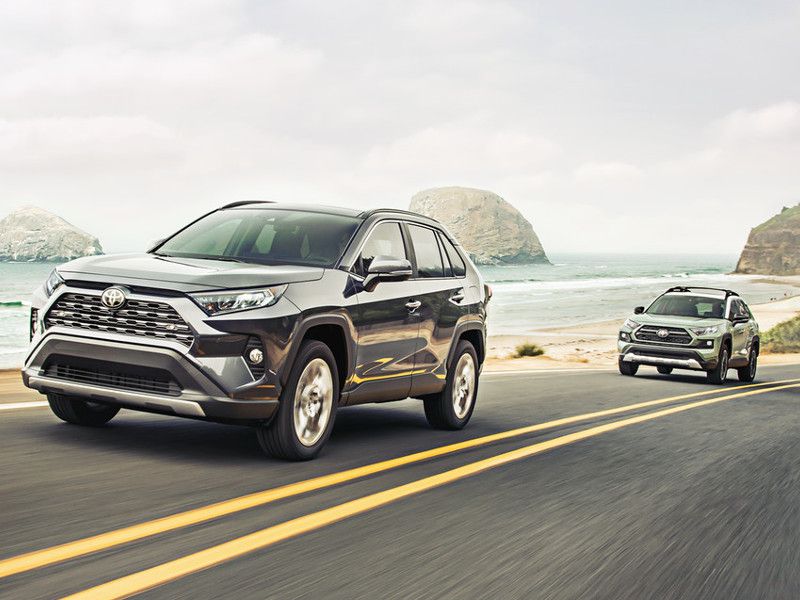
Photo by Toyota
Pricing and Value
The 2022 Hyundai Tucson lineup starts with relatively inexpensive front-wheel drive models and extends to luxury-oriented vehicles in the Limited trim. The Toyota RAV4 lineup is even more varied with on-road-oriented vehicles, off-road-oriented vehicles and, of course, the various hybrids. The RAV4’s starting price is a bit higher ($26,250) than the Tucson's ($24,950), but both are in the mid-$20,000 range. On the specialty-vehicle front, the RAV4 Adventure is around $33,000, and the TRD Off-Road is a shade over $35,000. Looking at the Hyundais, a bread-and-butter 2022 Tucson SEL with all-wheel-drive has an MSRP of just under $28,000, including the destination charge. The very luxuriously equipped all-wheel-drive Limited has a suggested list price of just over $36,000. The Hyundai Tucson N Line, which comes with a performance slant, has a suggested list price of $32,000 with all-wheel drive.
: Hyundai Tucson
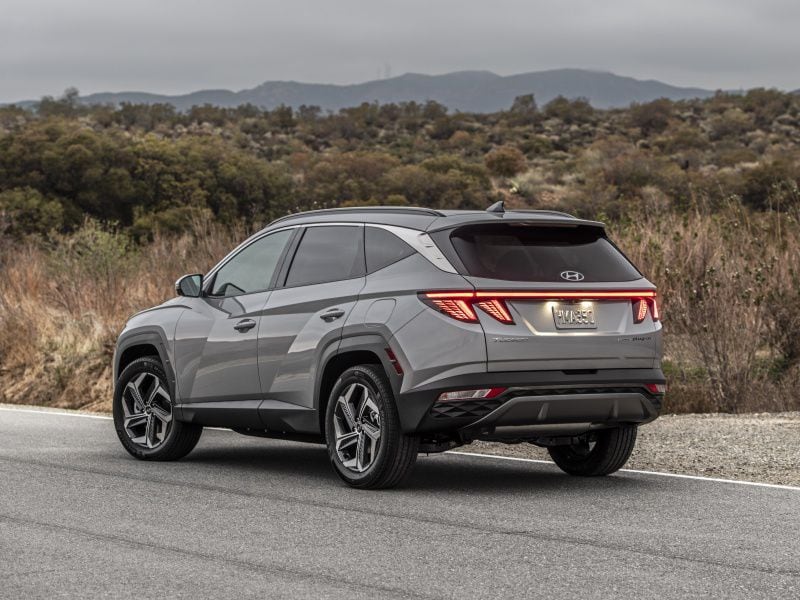
Photo by Hyundai
And the Winner Is…
Obviously, this is a very close comparison. We pit two of the best-selling SUVs in America against one another. The Tucson has been completely redone for 2022, and the RAV4 is an obvious rival to it. No wonder this face-off was close. The RAV4 offers off-road-oriented models that the Tucson doesn’t. Both vehicles have interesting conventional hybrid and plug-in hybrid models, although we haven’t driven the Tucson plug-ins yet. Both the Tucson and the RAV4 excel in everyday on-pavement driving. The Tucson offers more interior space and cargo capacity, while the RAV4 will tow more. Both the Tucson and the RAV4 have compelling quality stories to tell. In our final analysis, we have to go with the all-new model versus the model that is a few years old, so our winner is the 2022 Hyundai Tucson.
: Hyundai Tucson
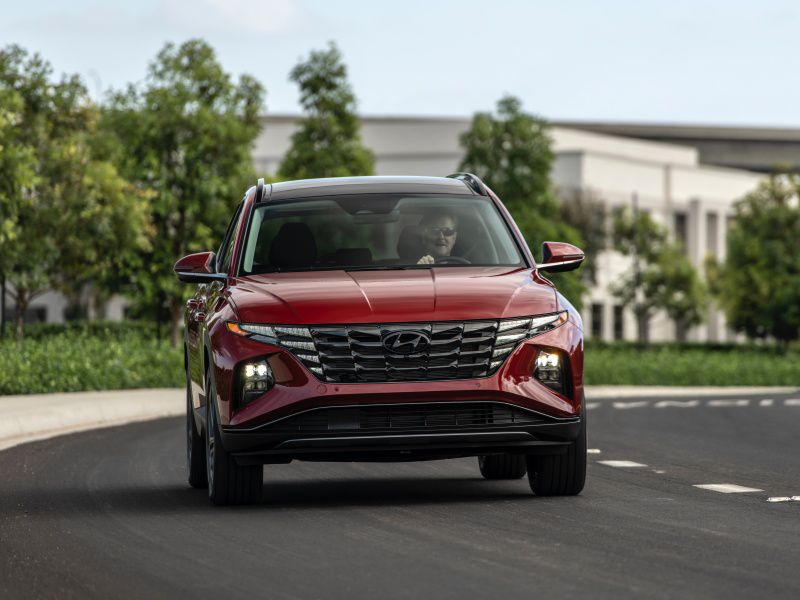
Photo by Hyundai